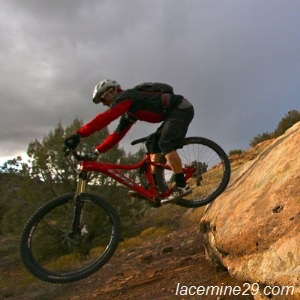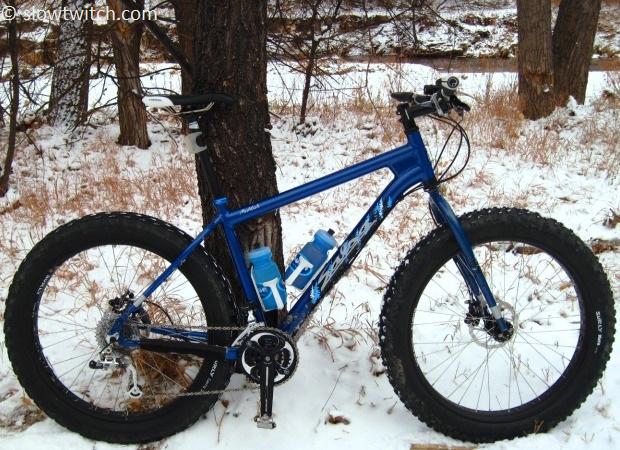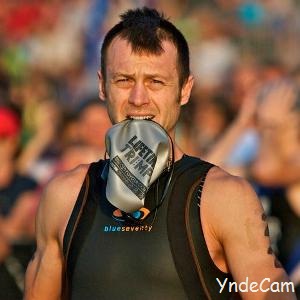The Journey of Mike Curiak

Editor’s Note:
I’ve been following Mike Curiak’s adventures for nearly a decade. There’s no other way to put it – the guy is a living legend. The best parallel I can think of in the triathlon world is perhaps Scott Molina – one of those folks who has been there, done that (and then some)… and still continue to pursue their sport with an intensity that most people couldn’t fathom.
Aside from being an exceptional athlete, Mike is a professional wheel builder, talented writer, and gifted photographer. As I found through the interview process, he’s also a heck of a nice guy. Mike’s blog, lacemine29.blogspot.com/, is one of the only blogs I’ve consistently followed since the word ‘blog’ came about. It’s well worth a peek, even if you only look at the photographs.
We hope you enjoy this rare interview with one of endurance sports’ most unique and accomplished athletes.
Slowtwitch: I know who you are, but I have a feeling that many of our readers – particularly the young crowd – may not. Can you give us the Clif’s Notes version of Mike Curiak – the man, the athlete, and the adventurer?
Mike Curiak: How the hizell does one answer that objectively?!
I had raced mountain bikes recreationally since I was a sophomore in college – way back in '90. Somewhere along the way I realized that the longer the race, the better my result would be – but more importantly, the more I would enjoy being out on the bike. I'm not a sprinter (think more along the lines of middle linebacker) and I just never could muster the top-end speed and quickness needed to win races. So I gravitated to longer stuff – 100 milers, 12 and 24 hour races. When the appeal of that stuff started to fade (you can only ride laps 'between the tape' for so long) I was drawn to go bigger and deeper into the mountains and woods – not just for racing, but because I enjoyed it so much. At some point I got a few consecutive wild hairs lodged somewhere painful, and spent the better part of a decade going bigger and deeper in an effort to exorcise them. I look back now and have no idea where the drive, determination, and tenacity came from. Seems like another lifetime.
In those few years I managed to win a handful of big, iconic, brutally beautiful races. More importantly, I was able to document them in such a way that they were presented to a wider audience than had previously been aware, leading eventually to a relatively massive increase in interest in these sorts of events.

Nowadays I still possess the skillset to go 'big', and a whole pile of equipment that's better than anything I had when I was good at this sort of thing. What I lack is the willingness to suffer, or even to endure mild discomfort. Seems I was sort of successful at exorcising those wild hairs after all…
ST: I recall keeping up with your happenings back when I was in college. At the time, I was completely floored by the concept of Iditasport – especially the 1k version. Can you give us the background on what this race is – how it got started?
Curiak: I don't have a good handle on the chronology – it's been going on a long time… at least since the mid/late '80's.
The best overview is the race website proper:
http://alaskaultrasport.com/alaska_ultra_home_page.html
The general idea being to race across a chunk of backcountry Alaska, in winter, with only yourownself to depend on. The early years there were ski and snowshoe divisions before bikes came on the scene. There were actually a few years where a 'tri' option was offered – bike/ski/'shoe, but I think the logistics of flying people and gear around bush Alaska ultimately smote that idea.
I caught wind in ~'95, did some research (which, in those pre-internet days, meant asking friends for info, learning that they knew nothing, then committing to go anyway) and stepped into it in '97 with the 100-mile event. At about mile 60 I folded my knee stepping into a hole left by a moose, and had to accept a snowmachine ride to a nearby cabin that night. Despite the fact that I was already DQ'ed for the sled ride, I "finished" the race by limping the last ~25 miles next to my bike. I just didn't want to quit. The official DNF bugged me all of that summer, so I signed up again in the fall. But that was when the 350 mile race appeared, and it was a time and place in my life when bigger and scarier held a lot more appeal.
I finished the 350 in '98, then went back in '99 to try to go faster, but had to bail due to avalanche hazard. As you can guess, pulling the plug due to outside circumstances didn't sit well, nor did losing my Marin factory [sponsorship] due to the DNF. The guy running the Marin race program at the time had no concept of avalanche hazard and there was just no explaining to him that it truly had been a matter of life and death. I spent that summer stewing about it and training harder and smarter than I ever had.

In '00, then-promoter Dan Bull announced a race called simply 'The Impossible', which was the full 1000+ mile distance of the Iditarod dogsled race. The idea of it scared me silly and gave me all the reason in the world to train, plan, and prepare as never before. I shocked myself *almost* as much as my fellow racers by winning that first 'impossible' race, and I've done some version of that event almost every year since.
ST: From what I recall, you did the race at least once (twice?) full unsupported solo for the 1,100. This is a big question to bite off and chew, but what was it like? How did you prepare? And – what did the entire experience teach you, looking back years later?
Curiak: Lots of big questions there – some familiarity with the event is assumed, and is probably best found with a bit of Googling. The way the [standard] race works is that there are a few checkpoints (roughly once a day if you're an average racer that takes about a week to finish [the 350 mile distance]) where you can resupply, get a meal, dry gear over a wood burner, and just generally gut check for the next section. Because of where and when this race happens, the ability to dry out gear and re-up on food is tremendous. Unless you've been out there, very few people can conceive of the distances between cabins or villages, nor of how long it takes to cover ground when that "ground" is deep snow and only lightly packed (if at all) by snowmobiles. A *great* day means covering ~75 miles in 16 hours of near constant movement. Then you stomp a little trench in the snow, roll out your bag and pad, and climb in for a few hours before waking in the dark and cold to do it again.

Also important to mention is that there is no set or marked course – just a web of trails, largely unsigned, and you are free to choose your own route from point A to B.
The best way to think about the self-supported trips – to put them in to a perspective that people can relate to is this: Step outside, wherever you are, and imagine the temperature is 35, 45, 50 below zero [degrees Fahrenheit]. Put a little pile next to you of all the clothing you’re going to need to stay warm, stay comfortable, stay alive – in that temperature. So just set that next to you – whatever it is. However many layers, however few layers, hats, gloves, puffy jackets, sleeping bag, tent – all of it.
Then.
Next to that pile, put a pile of everything you’re going to eat for the next three weeks. Whatever the snacks are, whatever the meals are, whatever you want to drink. All of it – one pile, of three weeks’ worth of food. You don’t get to go to a store any time in that three weeks – it all has to be right there in that pile when you start.
Likewise with a stove, so you can melt snow – to make water – so you can drink, and to rehydrate the meals that you’re going to eat – keeping in mind that freeze-dried meals are the best way to carry a lot of food in a light, compact package. Same with the fuel to run that stove – two meals a day for three weeks. On top of this, throw in a fat tire bike, with five-inch wide tires run at 3-4 psi. Take both of those piles, and find a way to strap all of that shit on to that bike in such a way that you can still ride the thing, get it up hills, get it down hills, etc. There’s a LOT more to it than that, but that should give you an idea.
ST: How many times did you race it in total?
Curiak: I raced it 8 years. Two years unsupported (finishing one of those years). [Editor’s Note: A video of the last seven days of Mike’s successful solo/unsupported 2010 journey can be found HERE.]
Then it morphed (courtesy of yet another wild hair?) from racing into something, um, else…
ST: Yes?
Curiak: Friends of mine in Alaska sent me a web link to this idea of the Overland Traverse, which goes from McMurdo Station on the coast of Antarctica to the South Pole. Basically this snow road, if you will, that the National Science Foundation was starting to experiment with. So that became the new focus – getting somewhere, instead of seeing old ground.

That’s what all of the self-supported trips of the Iditarod – all of the failures, and the one success – they were all just preparation for attempting to ride to the South Pole. Once you leave the coast on Antarctica, there is nothing else out there, so you have to be self-supported. As of yet, I’ve never really announced it, but I’ve spoken openly and enough people have put two and two together.
ST: I also understand you were one of the founders of the big Tour Divide race. Can you tell us about what that race involves, and how it got started?
MC: I started the Great Divide Race in 2003 as an individual time trial of the Great Divide Mountain Bike Route. It's a ~2500 mile mostly dirt route that follows and crisscrosses the continental divide from Canada to Mexico, and was (at the time) not very popular but for a handful of touring cyclists who'd spend the whole summer riding and enjoying the route. I made it halfway that first year before multi-systems failure caught up with me – knee and ankle issues from repetitive use were the main problems. Even now it is difficult to explain how much training, and planning, and preparation, followed by a huge amount of luck, goes into successfully pulling something like this off.
I went back in '04 and invited a handful of friends (actually I invited anyone that could walk and chew gum, but was joined by only a handful) to come race it. And by the second day I was hating it – how we were riding through such pretty country but couldn't enjoy or savor it, as well as how the route was billed as 'mountain biking' but was almost entirely on dirt roads. How can it be mountain biking when you spend the bulk of every day in the aero bars?! Despite similar physical woes and a host of equipment problems I somehow stuck with it all the way to the Mexico border.

Pete Basinger finished just behind me that year and most of the credit goes to him for keeping the race going beyond '04. I thought that it was a silly idea for a race and completely missed the point of actual mountain biking – fun, technical trail, shared with friends. He saw something I didn't and kept it going for a few years. It has since morphed into the Tour Divide – a very different event from what I created or envisioned. Seems popular, but maybe for the wrong reasons.
ST: It seems that the last few years your life brought a shift of gears, so to speak. You run your own business, but still seem to manage quite a few adventures. What does a day-in-the-life of Mike Curiak look like these days?
Curiak: Eventually I decided I was done racing… or maybe racing decided it was done with me. Up to that point I’d been working part time jobs, waiting tables, that sort of thing – because you could have lots of time off at a moment’s notice, and you could jump right back in to your job when you were done. Everyone knows that drill. Once I stopped racing, I started to look longer term. There was a niche that needed filling; this was 2004. Keep in mind this was the heyday, or perhaps the pre-heyday of when 29” [mountain bike] wheels were really starting to get popular. So I started a business building almost exclusively 29” wheels, called Lace Mine 29.
Perhaps serendipity, perhaps a lot of other reasons go in to it, but that business has continued to expand and thrive… going on 8 years now – 9 years now. I've been faced repeatedly with the same choices all small business owners face. Which means you can work and work and work and work and still be behind on all that needs doing, or you can hang the 'gone fishing' sign every now and again, go out and immerse yourself into something bigger and more important than your day-to-day, and in so doing remember why you started doing all of this in the first place. My business continues to grow and expand, perhaps in spite of me. I insist on getting away from the shop and the house for a week of every month – which doesn't always work out. But it's a good goal that keeps me thinkering up new places to go explore by bike, foot, or boat.

ST: From one longtime wheel builder and nit-picky mechanic to another, do you have a take on the modern ‘pre-built wheel phenomenon’? As you and I know, ‘back-in-the-day’, wheels were built by craftsmen who would specify different rims, spokes, and the like for different riders and terrain. Personally, I’ve never found a wheel that matches the reliability and durability of a hand built wheel that’s made to the proper specifications for a given rider.
Curiak: I would definitely agree with that – even taking my wheel builder hat off for a moment. You’re just not going to equal the level of versatility that you can build in to wheel by being able to spec the gauge of spoke, the number of spokes, the spoke crossings, nipple type, nipple length – and blah, blah, blah. There are just so many variables that you can account for with a hand built wheel.
But, manufacturers aren’t stupid. They understand that by offering a prebuilt wheel with a funky-looking design, deep-section rim – hot, bold colors! – all that sort of thing. They’re going to catch the eye of somebody who wants something right now, who doesn’t want to go through the process of figuring out every little component – who just can’t be bothered with that. So, there’s clearly a market for it. There wouldn’t be so many options out there if there wasn’t. And I don’t fault people for going that route, because it’s quick and it’s easy. But performance… you just can’t design a wheel that’s going to cover my 110lb wife, and the 280lb guy that I’m building wheels for right now. You’re compromising for just about everybody except a very narrow range.
ST: You’ve been one of the most consistent bloggers I’ve seen… well, ever. How long has your blog been running? Why do you do it?
Curiak: I think it's been going for ~5 years now. It is a great creative outlet for me with both words and photogeekery.
ST: Best cycling innovation in the last 15 years?
Curiak: The 29" wheel renaissance.
ST: Worst cycling innovation in the last 15 years?
Curiak: There's a whole host of electronic doodads out there that fall under this umbrella. They seem most adept at lightening our wallets and frustrating us (and those we ride with) yet have little to recommend themselves in the way of performance. I'm not a luddite, I just need to understand a cost/benefit relationship before plunking down the cash. And I'm not seeing it.

ST: What is your take on triathlon in general? Even if it doesn’t necessarily appeal to you – do you share any kinship with the ‘Ironman crazies’?
Curiak: {laughs} I really don’t have a lot of triathlete or Ironman friends anymore. They’re still kind of going down that road, and we don’t spend that much time together anymore. But – I bring that up because of the mindset. Everyone I’ve known that’s been in to triathlons has been fanatical OCD. They can relate to [what I do] – having to manage every last detail. Maybe they haven’t looked at exactly something like a 3-week unsupported trip, but you start talking about details and panning it out for them, they start saying “Oh, yeah!” Then they start asking, “Well, how much toilet paper do you bring for three weeks?” {laughs}
I actually signed up for an off-road ironman here in CO maybe 8 or 10 years ago. I was all jazzed to do something new and intimidating – keeping in mind that riding an off-road century might be easy, but I hadn't swam in years and can't run to the end of my driveway without stumbling and falling. As with most of the events that I used to do (and am still attracted to), the fact that I wasn't sure I could do it was the most appealing. If it was a sure thing that I could finish, just a question of how fast or slow, that held little appeal then or now. I suspect that many of the newer or back-of-the-pack Ironmen and women feel the same.
ST: Last, we’d like to share a photo of your custom Moots snow bike that has carried you all over Alaska (or rather – you pedaled and pushed all over Alaska). Can you tell us about the specifications?

Curiak: As far as specs on the bike, it's got a saddle, post, bars and stem that put my hands, feet, and butt in places that feel comfy to them. That's the important part, how to get there is different for everyone!
I run 6" Hayes Stroker hydro brakes because I don't care for the frequency with which cable-actuated discs freeze (the cables, not the brakes) in winter conditions.
I like Grip Shift because it's easy to use with heavy gloves and/or frozen fingers. I use 9 speed (on this and all of my other bikes) because it works, it's cheap, and so am I.
The fork pictured stores 17oz of fuel in each leg. Frame holds 70oz [in the tank at the bottom of the main triangle]. All are decanted via brass plumbing valves (you can see the one just in front of the BB) I sourced from my local hardware store. I typically use anywhere from 3.5 to 5oz of white gas per day (running an MSR XGK stove) to melt snow to provide all of my hydration and rehydration (as in, the meals) needs. 5 oz x 22 days = just shy of a gallon of fuel. Think of the space I saved in my bags by storing it in the frame/fork tubes. Not to mention removing the likelihood of a leaky container fouling my food supply.
As-pictured that bike weighs roughly 38 pounds. With both racks, 4 panniers, and all of my other shiznit for a 3-week self-supported trip strapped on there, it's roughly 155 lbs. And because I am a cyclist, that means that no, I cannot lift the whole thing off the ground at once. One wheel or the other, briefly, is about it.
Front and rear wheels are swappable, just in case. I have actually needed this feature not because of hub failure, but sidewall failure from running ~3psi through soft snow and rough ice for ~600 miles. Had to switch the fresh tire to the rear, and it was easier to just swap wheels than deal with deflating/swapping/reinflating both tires.
All photos courtesy of Mike Curiak / Lacemine29.com




